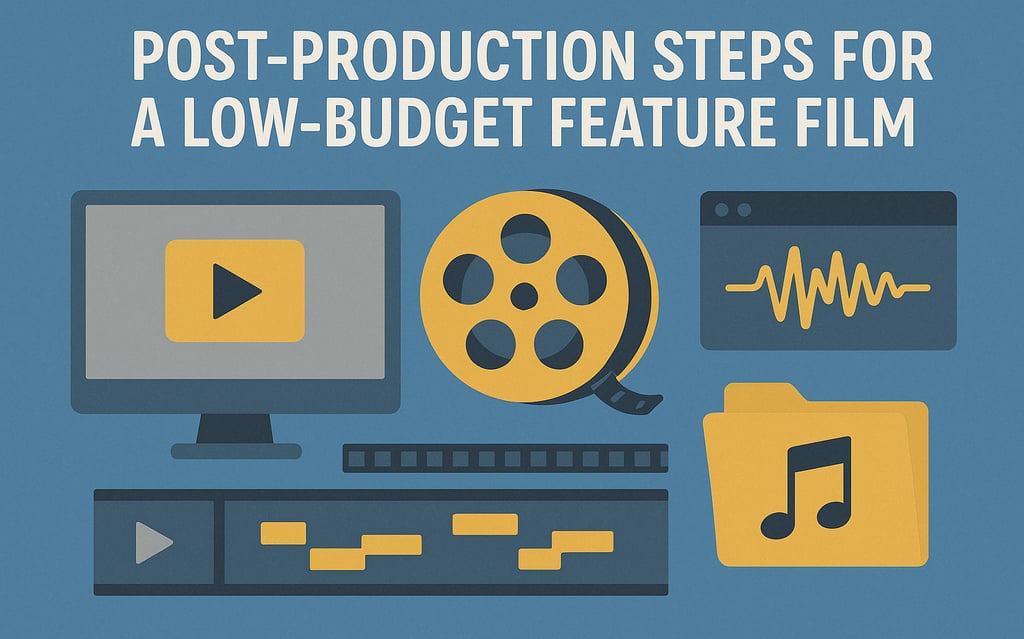Post-Production Steps for a Feature Film
This comprehensive post‑production guide ensures a smooth, professional finish.
Rahul Verma
7/24/20252 min read


This comprehensive post‑production guide ensures a smooth, professional finish. First, back up and organize footage using a clear folder structure and tools like DaVinci Resolve or Premiere Pro. Edit by assembling, rough‑cutting, and refining, involving your editor early. Clean and enhance audio—dialogue, ambience, foley—using Audition or Audacity. Select and license music from royalty‑free or original sources. Balance and grade color to unify and stylize your story in Resolve. Add essential VFX sparingly, and design clean titles and credits. Export high‑res masters and delivery files, then perform multi‑device QC. Finally, create promotional deliverables, subtitle files, and archive all assets securely.
1. Ingest & Organize Footage
Back up footage to at least two locations (RAID drive + cloud/external).
Create a consistent folder structure (by scene/day).
Use software like DaVinci Resolve, Premiere Pro, or Avid Media Composer.
2. Picture Editing
Start with an assembly cut (everything in order).
Move to a rough cut, then refine to fine cut.
Keep the editor involved from pre-production if possible—they’ll work faster with story context.
Consider free or discounted licenses (DaVinci Resolve is excellent and has a free version).
3. Sound Editing
Clean dialogue, remove background noise.
Add ambience, foley, and effects.
Use tools like Adobe Audition, Reaper, or Audacity (free).
Consider hiring a freelance sound editor for a few days to polish.
4. Music & Score
Use original compositions, royalty-free libraries, or AI-generated tracks.
Platforms: Artlist, Epidemic Sound, Free Music Archive.
License properly to avoid distribution issues.
5. Color Correction & Grading
Start with color balancing (make shots consistent).
Then apply creative grading to build mood.
Use DaVinci Resolve (industry standard, even in free version).
6. Visual Effects (If Any)
Only what’s absolutely necessary.
Consider After Effects, HitFilm Express, or Blender (for 3D/VFX).
Plan for VFX in pre-production to avoid reshoots.
7. Titles & Credits
Create professional opening/closing titles.
Credit everyone, especially on collaborative projects.
Fonts: clean and legible. Tools: After Effects, Canva, or even Premiere.
8. Export & Master
Export high-res master (ProRes, DNxHR) and delivery formats (H.264 for web, DCP for cinema).
Double-check for technical errors (levels, titles, spelling).
9. Quality Control (QC)
Watch on multiple devices (laptop, TV, projector, headphones).
Check audio mix, brightness/contrast, and subtitle timing (if included).
10. Create Deliverables
Trailer, poster, stills, behind-the-scenes.
Subtitle files (SRT) and transcriptions (optional but good for festivals).
Press kit (if festival or distribution-bound).
11. Backup & Archive
Archive final cut, raw footage, project files, and deliverables.
Cloud backup + physical storage.
Post-production shapes your film into its final form. With careful planning, creative tools, and efficient workflows, even low-budget films can achieve professional polish. Prioritize story, sound, and pacing, and always backup your work. Smart post-production maximizes limited resources and elevates your film's impact for audiences and festivals alike.
